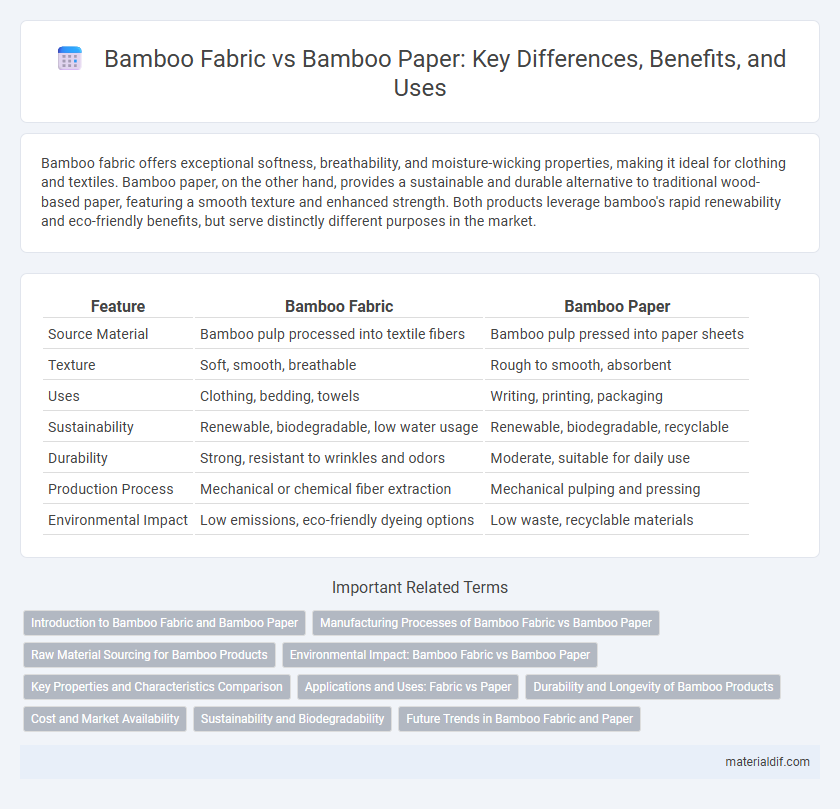Bamboo fabric offers exceptional softness, breathability, and moisture-wicking properties, making it ideal for clothing and textiles. Bamboo paper, on the other hand, provides a sustainable and durable alternative to traditional wood-based paper, featuring a smooth texture and enhanced strength. Both products leverage bamboo's rapid renewability and eco-friendly benefits, but serve distinctly different purposes in the market.
Table of Comparison
| Feature | Bamboo Fabric | Bamboo Paper |
|---|---|---|
| Source Material | Bamboo pulp processed into textile fibers | Bamboo pulp pressed into paper sheets |
| Texture | Soft, smooth, breathable | Rough to smooth, absorbent |
| Uses | Clothing, bedding, towels | Writing, printing, packaging |
| Sustainability | Renewable, biodegradable, low water usage | Renewable, biodegradable, recyclable |
| Durability | Strong, resistant to wrinkles and odors | Moderate, suitable for daily use |
| Production Process | Mechanical or chemical fiber extraction | Mechanical pulping and pressing |
| Environmental Impact | Low emissions, eco-friendly dyeing options | Low waste, recyclable materials |
Introduction to Bamboo Fabric and Bamboo Paper
Bamboo fabric is a sustainable textile made from bamboo cellulose, prized for its softness, breathability, and moisture-wicking properties, making it ideal for clothing and home textiles. Bamboo paper, derived from bamboo pulp, offers durability and eco-friendliness as an alternative to conventional wood-based paper products, reducing deforestation and chemical use. Both bamboo fabric and bamboo paper leverage bamboo's rapid growth and biodegradability, positioning them as environmentally responsible materials in the textile and paper industries.
Manufacturing Processes of Bamboo Fabric vs Bamboo Paper
Bamboo fabric manufacturing involves mechanically or chemically breaking down bamboo fibers through processes like viscose or lyocell production, resulting in soft, breathable textiles ideal for clothing. In contrast, bamboo paper production uses bamboo pulp derived from mechanically or chemically processed bamboo fibers, pressed and dried into sheets for writing or packaging purposes. The fabric process emphasizes fiber extraction for textile quality, whereas paper focuses on pulp refinement for strength and texture.
Raw Material Sourcing for Bamboo Products
Bamboo fabric is derived from bamboo pulp that undergoes extensive processing to create viscose or lyocell fibers, ensuring sustainable sourcing through rapid bamboo growth and minimal pesticide use. Bamboo paper, on the other hand, is produced by mechanically grinding bamboo stalks into pulp, retaining more of the plant's natural fibers and requiring fewer chemical treatments. Both products prioritize eco-friendly raw material sourcing due to bamboo's high yield per acre and natural regeneration capabilities, reducing deforestation and environmental impact.
Environmental Impact: Bamboo Fabric vs Bamboo Paper
Bamboo fabric and bamboo paper differ significantly in their environmental impact due to their production processes and resource use. Bamboo fabric manufacturing typically involves chemical treatments and energy-intensive steps that can produce pollutants if not managed responsibly, whereas bamboo paper production generally requires fewer chemicals and less energy, resulting in a lower carbon footprint. Sustainable sourcing of bamboo and implementing eco-friendly processing methods for both fabric and paper are crucial to minimizing deforestation, water consumption, and emissions associated with bamboo products.
Key Properties and Characteristics Comparison
Bamboo fabric boasts softness, breathability, and moisture-wicking properties, making it ideal for clothing and textiles, while bamboo paper is valued for its durability, smooth texture, and eco-friendly production process. Bamboo fabric is naturally antibacterial and hypoallergenic, enhancing comfort, whereas bamboo paper offers high tensile strength and resistance to tearing, suitable for printing and writing applications. Both materials leverage bamboo's sustainability, but their distinct physical characteristics cater to different functional needs.
Applications and Uses: Fabric vs Paper
Bamboo fabric is widely utilized in textiles, offering sustainable options for clothing, upholstery, and bedding due to its softness, breathability, and moisture-wicking properties. Bamboo paper excels in eco-friendly packaging, writing materials, and hygiene products, favored for its strength, biodegradability, and reduced chemical processing compared to traditional wood pulp paper. Both materials leverage bamboo's rapid growth and renewability but serve distinct markets--textile industries prioritize fabric for wearable and home goods, while paper industries focus on environmentally responsible paper alternatives.
Durability and Longevity of Bamboo Products
Bamboo fabric exhibits superior durability due to its natural fiber strength and flexibility, making it resistant to wear and tear while maintaining softness over time. In contrast, bamboo paper, although eco-friendly, typically has a shorter lifespan because of its thinner, less robust fiber composition and vulnerability to moisture damage. Choosing bamboo fabric ensures longer-lasting products ideal for clothing and upholstery, whereas bamboo paper serves best in applications where biodegradability and sustainability outweigh durability concerns.
Cost and Market Availability
Bamboo fabric typically commands higher prices than bamboo paper due to complex processing methods required for textile production, such as viscose or lyocell techniques. Bamboo paper benefits from more straightforward manufacturing, resulting in lower costs and wider market availability, especially in stationery and packaging industries. Increasing demand for eco-friendly products is driving growth in both segments, but bamboo paper remains more accessible and affordable for consumers globally.
Sustainability and Biodegradability
Bamboo fabric and bamboo paper both offer sustainable alternatives, with bamboo's rapid growth requiring minimal water and pesticides, significantly reducing environmental impact. Bamboo fabric is biodegradable and decomposes faster than conventional textiles, while bamboo paper breaks down quickly without releasing harmful chemicals. Both materials support reduced deforestation and contribute to eco-friendly product cycles through their natural renewability and efficient biodegradability.
Future Trends in Bamboo Fabric and Paper
Advancements in bamboo fabric technology emphasize enhanced softness, durability, and eco-friendly dyeing methods, anticipating increased adoption in sustainable fashion and home textiles. Bamboo paper innovations focus on integrating biodegradable additives and waterless production techniques to reduce environmental impact and improve recyclability. Emerging trends indicate a convergence of smart, functional properties in both bamboo fabric and paper to meet growing consumer demand for sustainable, high-performance materials.
Bamboo fabric vs bamboo paper Infographic

 materialdif.com
materialdif.com